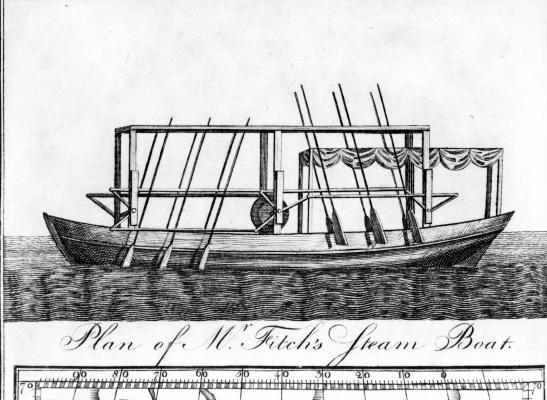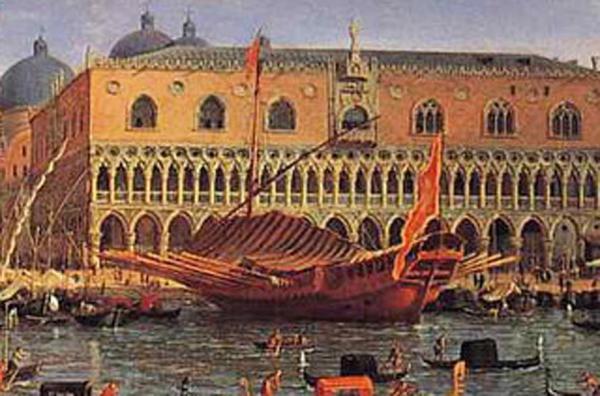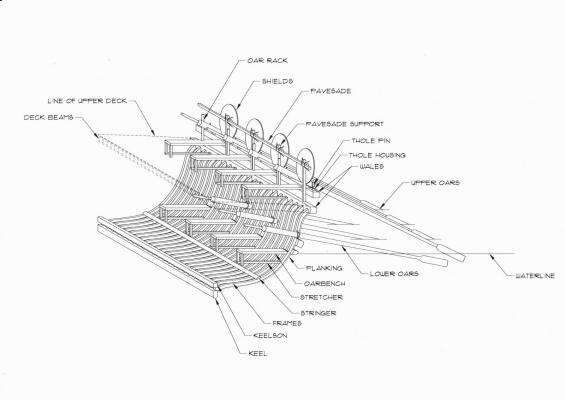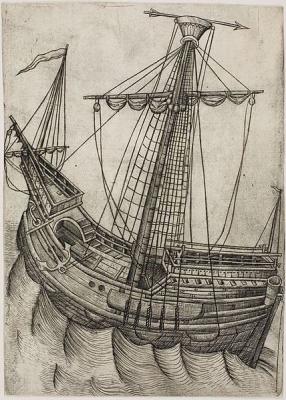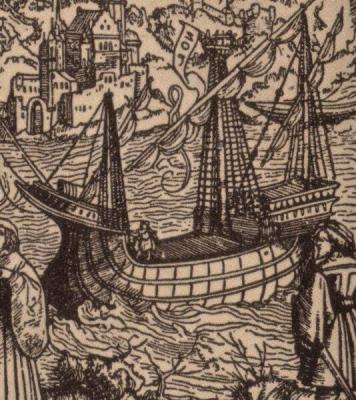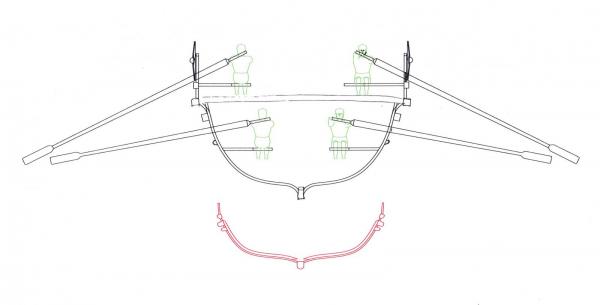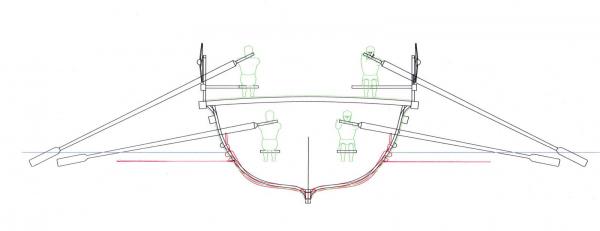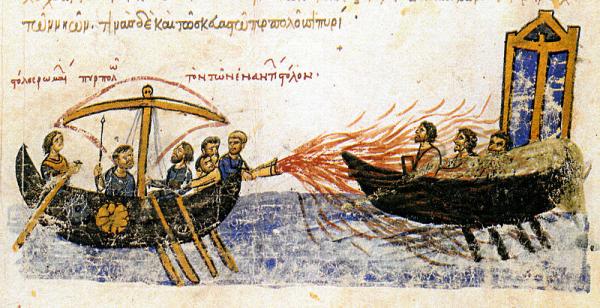-
Posts
7,987 -
Joined
-
Last visited
Content Type
Profiles
Forums
Gallery
Events
Everything posted by Louie da fly
-
That sounds like the best way to go, Ben. I was wondering if that'd be an option. I wish you the greatest success with it. By the way, there are other intersting "oar-powered" vessels out there which would lend themselves to RC. The most interesting in my book is the steamboat built by the American John Fitch in the 18th century - see http://www.nysl.nysed.gov/mssc/steamboats/player_fitch2.htm . The clearest representation I've seen of the boat is below. Thought you might be interested. Steven
-
Thinking about Dick's question regarding the relationship of the frames to the lower oarports, I've come up with what is probably a workable answer. Working on a spacing of 0.96 metres between benches (as this seems to be pretty much the average found at Yenikapi), that would also mean 0.96 metres between oarports. The average spacing between frames found at Yenikapi seems to be between 200 and 230mm, which is between 1/4 and 1/5 of that distance. If I spaced the frames at 240mm centres, there would be exactly four of them between adjacent lower oarports, and there would be no need to modify the frame spacing to allow for them. With the Yenikapi ships the shipwrights had no need to worry about this issue because those had only a single bank of oars. YK16 had two upper wales with a 55mm strake between them (and I believe YK4 is similar) with the benches mortised into the lower wale, and it appears the thole supports were fixed to the upper wale. As the frames end at the top of the upper wale, there would have been no need to take them into account when spacing the frames. Another point is that this was a time of transition when ships were being built "shell-first" - that is, the keel was laid and the planks fixed in place before the frames were added. This would have given the shipwright more freedom when deciding on spacing of both oarports and frames. I'm sure when it came to building dromons the shipwrights with several hundred years of experience behind them would have worked out in advance how to place the frames so the oarports would not cause problems. However, as no dromons have ever been found, we can only speculate and use what's been found on the Yenikapi ships as a basis for a 'best guess' design. Steven
-
Thanks everybody for the "likes". They are much appreciated. Dick, I'm using AutoCad LT 2006, which I use in my 'real world' business designing houses. I find it very helpful, but it's only in 2 dimensions (3D AutoCad is prohibitively expensive). I take your point about frame positions, and for the midships section I'll probably come up against this if I decide to do it in full. However, the Yenikapi ships show considerable variation in the spacing of their frames, benches and oarports, and the spacings quoted are only averages. So I might be able to "tweak" the spacings to allow the oarports to go between the frames without playing around too much with the frames themselves. Additionally, there are quite a few frames on each of these ships where the different frame members are next to each other instead of in the same line, so that could be done as well without feeling I'm departing too much from what was actually done. This has turned out to be quite a challenging build, and I haven't even picked up a piece of wood yet! Steven
-
Oh, I wasn't proposing that all the oars would be stored inboard; only the upper bank, and only immediately before and during battle, at which time the masts were also lowered, and the uppr oarsmen became fighters - the lead oarsman on one side becoming (and I love this name) the siphonator, operating the Greek Fire apparatus. As you say, the lower bank would be needed for manoeuvring, and yes, you're right, there's a case on record where the upper deck was overrun and the lower oarsmen weren't, though there are various versions of the story, including one where the lower oarsmen rowed in the opposite direction to the (enemy) oarsmen of the upper bank. This is covered in Age of the Dromon, but Prof Pryor doesn't believe it's physically possible, and that instead the chronicler embroidered the orginal story. Another reason to store the upper oars inboard is that they would otherwise, particularly if fixed in the same way as those in renaissance galleys (see below), get in the way of missiles being fired at the enemy vessel. The lower oars would certainly help provide lateral stability, which would be very important in a vessel as inherently unstable as these. By the way, I'm amending my earlier post to replace the drawing I attached with one which I hope more accurately depicts what I have in mind, including getting the oars and shields in the right relationship to each other, and adding the leather thongs to the thole pins. Steven PS: Kees, I'd also thought that galleys were always rowed by slaves. It took reading The Age of the Galley to change my mind about that.
-
Dick, you make a good point, and certainly renaissance galleys had their oars at "rest" angled upward but supported in their rowlocks. However, they were used in a very different kind of fighting where a galley's function was to sink other vessels with gunfire. They also had only a single bank of oars, which they kept in use during a battle. Mediaeval galleys' crews relied on attrition of the enemy's crew with missile fire, followed by boarding, and after a lot of thought about this, I believe the upper bank oarsmen would have been most likely to put their oars in "storage" to give them the greatest freedom of action. But my proposal is that they are stored running fore and aft right next to the sides of the ship. In this way they shouldn't restrict mobility on board. You're right, though - the approved tactic seems to have been to try to attack an enemy vessel from the quarter, preferably smashing up their oars with the bow-mounted spur, followed by boarding. I can only think the lower oarsmen must have pulled their own oars inboard (they were shorter than the upper ones) just before impact, but the information available is so thin on the ground that we really know nothing for certain. Even the replacement of the ram with a spur is still not fully accepted by academics, let alone a lot of the other information we have on battle tactics. Much of the contemporary battle advice, such as the treatise of Emperor Leo VI, seems to have been written from the comfort of an armchair by someone who'd never been to sea. The flare of the upper works is in fact what Prof Pryor believes is the only possible solution to the problem of clashing oars. He devotes a whole chapter of Age of the Dromon to this problem, but he acknowledges that it's still only theory till it's tested in the real world. Kees, the oarsmen in galleys of antiquity and the middle ages were free men, and galley slaves don't seem to have been introduced until the renaissance, as a response to a shortage of skilled oarsmen and freemen willing to work at the oars. Rowing a galley was a skilled activity, and good oarsmen were valuable. The most valuable on a dromon were the upper oarsmen, as they doubled as fighting men, and Leo VI recommends that the less brave of the oarsmen be placed on the lower bank. Steven
-
I don't know how much of the ship was below the floor planking, but there are cross sections at http://nautarch.tamu.edu/class/316/oseberg/ and at http://www.gutenberg.org/files/33098/33098-h/33098-h.htm#f22 which might let you know if it's enough to fit your radio control equipment below it. Hope that helps, Steven
-
Here’s a drawing of the proposed midship section for the dromon, to be built at a scale of (probably) 1:20, and intended to sort out whether the upper and lower banks of oars will successfully avoid fouling each other when in action. I haven’t decided how detailed to make it – just a basic mechanical construction to test out the above question, or something fully detailed? After all, the dromon itself is the main goal, but in the meantime I’ve drawn the section in full, in case I choose to do it that way.. Though for the full model I’ve followed Professor Pryor’s lead in having the oar benches angled at 18.4 degrees to an athwartships line , I’m still in two minds about it, and I’ve shown the benches in this section as being directly athwartships (i.e. at right angles to the keel). Interestingly, a thole and its “housing” were found in one of the Yenikapi wrecks, but the housing only contained a single hole. Experience with the Olympias reconstruction showed that most of the force expended by the oars at the fulcrum was taken not by the thole pins themselves, but by the leather thong which tied the oar to them. I've now shown the thongs on the drawing, but I haven’t yet added the leather sleeves for the lower oarports, designed to keep water out. As the upper oarsmen doubled as marines during sea-battles, and fought the ship rather than rowing - I've had to figure out what did they do with the oars. The dromon is 4.4 metres wide at its widest point, but the upper oars are over 5 metres long. You can’t pull them inboard – they’d stick out by about a metre either side, making it impossible to come alongside and grapple the enemy (and expose the delicate ends of the oars to damage). Not only that, but it would be murder trying to clamber over them to get from one part of the ship to another – an important consideration during a battle. If you lay the oars fore-and-aft along the deck inboard of the benches, they obstruct access to the benches themselves (the benches are only about a metre apart, so you’d have a stack of oars rolling around getting in the way). The best solution I've been able to come up with – and I’m aware it can’t be proven to be correct – is to have a row of uprights sticking up out of the benches about three oars’ thickness in from the side of the ship. The oars can be racked between these uprights and the side, two or three high, with very little obstruction either for access to the benches or for crew fighting at the side of the ship. Another question I have yet to resolve – was there a catwalk for the oarsmen of the lower bank, or did they simply walk along the tops of the frames? I believe the frames would be close enough together (200-230mm or 10-11 inches) and sturdy enough to be walked on, so a catwalk would be unnecessary. You’ll note the ship has several heavy wales – about 150mm (6 inches) square, to help prevent hogging, and a stringer running along the bottom for the same purpose. These have been found on the Yenikapi galleys, and on a dromon the deck would strengthen the vessel further. There are shields along the sides to protect the upper oarsmen, and it’s mentioned in contemporary accounts that they fought from behind them. The shields are supported by a rail known as a pavesade, probably hung from the pavesade uprights by the enarmes – the leather or rope straps by which the warrior carries his shield in battle. At sea the shield would also have to be tied down further so it wouldn’t flap around with the movement of the ship. Steven PS: The attached drawing has now been amended to show (I hope) the proper relationship of oars, shields etc.
-
Well, Viking ships came in all kinds of sizes - from the Wikipedia entry: "Longships can be classified into a number of different types depending on size, construction details and prestige. The most common way to classify longships is by the number of rowing positions on board. Types ranged from the Karvi, with 13 rowing benches, to the Busse, one of which has been found with an estimated 34 rowing positions." So perhaps you'd be interested in making a Karvi. The only problem that might arise is that Viking longships were basically just really big open boats so there'd be a difficulty hiding the radio control mechanism, if that's the way you're planning to go. Otherwise - go for it! I may be able to help; having spent many years as a Viking Age re-enactor, I've done a lot of reading on Viking ships and might be able to answer questions as they come up. The model is looking really good. I'm very impressed, and look forward to seeing her in action in the water. Steven
-
But your galley is already a warship – that’s why it’s got a ram! I’m not sure the smallest war galley that existed in Ancient Greece, but the most common before the introduction of the trireme was the pentekontor (or penteconter) – the 50-oared galley. The 50 oars was I think a pretty loose description, and I think yours would count as a pentekontor despite only having 44 oars. The best and most comprehensive book I know on galleys is The Age of the Galley, http://www.amazon.com/s/ref=nb_sb_noss?url=search-alias%3Dstripbooks&field-keywords=the%20age%20of%20the%20galley and I’d highly recommend you get hold of it if you can – perhaps your local library can obtain it. It gives a good overview (and a lot of theoretical detail as well) on Mediterranean galleys of the ancient, mediaeval and renaissance eras. The video of the model galley ramming the merchant ship is pretty cool, but it looks like the oarsmen must have taken performance enhancing drugs to get that rowing rate. Perhaps the owner needs to gear the thing down a bit. I don't really know what would be the best material to represent leather for the oarports - perhaps fine fabric with varnish or some other sort of goop through it? Or thin vinyl? I don't think real leather comes thin enough to do the job. On Olympias the sleeves were made of four pieces of leather, each in the shape of a tapered rectangle (if that makes sense - I suppose I could call it a trapezium), and sewn together at the edges. An interesting thing about ancient vessels, galleys included (at least if I read The Age of the Galley right), is that they were built without frames – the planks were fastened edge to edge with hundreds of coaks – small tenons fitting into slots cut into the edges of adjoining strakes, in the same manner as “biscuit” joints in modern woodworking. The skill and precision needed to do this completely blows my mind. Even when frames were introduced in the early Middle Ages, they were added after the shell was built, and coaks survived till at least the 11th century AD, though in much reduced numbers. It was this frameless construction that made ancient galleys vulnerable to ramming – the coaks just broke or came undone, letting the water in. Vessels with frames were too strong for ramming to be effective, and rams disappeared from the scene. Fascinating stuff . . . Steven
-
Galleys were built incredibly light - the Byzantine ones they've found in Istanbul's Yenikapi district have frames 50-60mm (2 to 2.4 inches) square in section, and the planks were 20-30mm (3/4 to 1.18 inches) thick. The oarports are that close to the water, and they've found nail holes which seem to confirm the existence of leather "bags" around the oarports, something mentioned in Ancient Greek texts. Olympias, a reconstruction of an Athenian trireme is 121 feet long, with a crew of 170. There's a video of her sea trials at https://www.youtube.com/watch?v=ZcsrNrRkQis which is very enlightening. The practical trials turned up a lot of worthwhile data - the Olympias didn't reach speeds as fast as recorded in antiquity, and it is thought that the speed would have been higher if the distance between oar-benches had been slightly greater to allow the oarsmen freer action. It's also believed there would have been less interference between oars (and fewer broken oars) if the arrangement of the oars had been somewht different. Olympias was very sensitive to changes in trim - even the movement of one person on the top deck. All galleys were very sensitive to weather conditions and generally completely unsuitable in seas above 3 feet high. There are many recorded instances of entire fleets of galleys being lost in storms, and the Mediterranean campaigning season was only during the calmer months of the year, and even then an unexpected storm could be catastrophic. Nonetheless. the galley was the front line warship of the Mediterranean for over 1000 years. Steven
-
The other thing is that perhaps many of the ships pictured were portrayed as the artist saw them, in harbour, empty except for ballast, waiting for a cargo. Carpaccio's St Ursula carracks certainly seem to be riding high enough in the water for this to be so, and probably several others. Steven
-
Well, if as Dick says many the pictures are taken from ships out of water (or sitting in dock empty) this would be understandable - the artists simply got the position of the waterline wrong. Looking at the picture immediately below the photo of the model seems to me to show a more likely position for the waterline. And other contemporary representations, though they do seem to be riding fairly high, show a more realistic waterline position.
-
I dips me lid, Dick. That is seriously beautiful work. If I can get to that kind of standard, I'll be very happy. And every time I think there couldn't be any extra pictures of carracks, you come up with more! Wonderful stuff. Steven Jan B. Not to derail the thread, but those flying cats are just amazing.
-
A couple of days ago I saw in the archaeological report of Texas A&M University's excavation of ships from the Yenikapi find in Istanbul, something I hadn't noticed before . The drawing of the most intact galley of all, a light galea known as YK4, includes a diagram of the 35th frame of the vessel, which is effectively a midship section. Out of curiosity I printed it off as large as I could, drew up a grid of 1 metre squares around it and copied its shape on my computer to the same scale as the plans for the proposed dromon model, taken from Professor John Pryor's reconstruction. To compare the two I superimposed the images, and the correspondence was uncanny - at the point they diverge most, the discrepancy between the two shapes is only about 50mm! That a theoretical reconstruction, particularly given the scarcity of information available to base it on, turned out to be so close to the archaeological reality is amazing. Needless to say, I was very impressed, and I take my hat off to Professor Pryor. The only major difference I could see was that the dromon's tholes appeared to be about 170mm higher than those of the ship found in Istanbul. But that was a galea, vessel with just a single bank of oars. A double-banked dromon would be considerably larger and heavier and would sit deeper in the water, so the tholes would be lower. Taking the galea's waterline as being at the bottom of the lowest of the three wales, I re-did the superimposition. They line up perfectly. This has confirmed my confidence in the reconstruction, and that I'll be making something that is very close indeed to the reality of the actual vessel. Steven
-
Well the Texas A&M University built the bow half of the more complete galley they excavated, but at a scale of 1:10 it took up all the room they had available. I'm afraid my model will have to be POB, as the frames on the original are so frail it would be impossible to do it POF to 1:50 scale (they'd be about 1.2x1.2 mm) and the planking would be 0.4mm thick! But I believe even POB it's going to shed a fair bit of light on how these vessels worked. The whole subject of how they travelled in these things is fascinating. For example, after several hours' rowing, what would they do for toilet breaks? Would there be a rush for the side, unstabilizing the ship? Would they have to have a roster? Who knows . . . Steven
-
I've added a couple more PDFs of the dromon drawings - a transverse section with crew, and views showing just the vessel itself - (no crew, oars, shields etc) showing the shape of the hull more clearly. The thing is incredibly narrow - at 1:50 it's 62.5 cm ( just under 2 feet) long, but only 9cm (4 inches) wide. The drawings aren't to any particular scale - I had to reduce them to fit on an A3 sheet. As you can see, not much room in the ship once the crew's aboard. I haven't really sorted out the rigging yet - I have more work to put into it, but there's plenty of time for that before I get to the stage where it's needed. Apparently a Greek Fire projector emits a very loud roaring sound when it's in operation. You might note that it's in the shape of a lion, an innovation introduced in the late 11th century by Emperor Alexios I, to further terrify the enemy - as if flames shooting across the waves at you, and the surface of the water burning wasn't enough! Steven PS: Sorry about the pictures being on their side. Just the way they turned out, I'm afraid. transverse section crewed.dwg Model (1).pdf dromon hull only.pdf
-
Well, actually I just wrote to Professor Pryor and to my surprise he answered. Perhaps that he was at the University of Sydney and that anybody else in Australia was interested in dromons had something to do with it. I've had success with this kind of thing in a previous life as a mediaeval re-enactor, by the way. I've written to the UK, France, even Hungary and got replies - even in one case a copy of a paper written by the person I wrote to. It's been my experience that academics are often quite willing to help someone in the lay public who shares their enthusiasms. I've had my share of 'no replies' as well, but all in all I've been pleasantly surprised by the generosity and helpfulness shown by specialists whom I've asked for assistance. Steven
-
This is the very beginnings of a build log. Until I have finished renovating the house, there’s no chance of actually doing any building – no time, and no space available. But in my free moments I’ve been researching and drawing up plans for a Byzantine dromon of the 10th-11th century. The name dromon (Greek = “runner”) was originally applied to a class of fast Roman galleys with a single bank of oars developed around the 6th century AD. Over the centuries, as the Roman Empire shifted its emphasis to the East and gained a new capital in Constantinople (modern Istanbul) and evolved into what we now know as Byzantium, the dromon changed as well, until by the 10th century AD it was a very different vessel with two banks of oars, lateen sails and armed with a devastating weapon, pyr thalassion – Greek fire. Greek fire is generally accepted as having been made of naphtha, a naturally occurring substance similar to petroleum. Contemporary descriptions led Prof. John Haldon to work out theoretical design using only technology known at the time, and then put it into practice, with spectacular results (see https://books.google.com.au/books?id=q0hMf5vu7kgC&pg=PA289&lpg=PA289&dq=%22Greek+fire%22+revisited:+recent+and+current+research%22&source=bl&ots=Kwp5Xa3U62&sig=tR81SBsNfAc_uDLyuXDxe9uPWKA&hl=en&sa=X&ei=bjAzVc61C8TNmwWvv4HICw&ved=0CCYQ6AEwAw#v=onepage&q=%22Greek%20fire%22%20revisited%3A%20recent%20and%20current%20research%22&f=false - page 292 onward). Greek fire was used effectively in a considerable number of battles, destroying threatening enemy fleets. I was reported to have burnt on the surface of the water (and in the reconstruction that’s just what it does!). The definitive source on the dromon is the excellent, thorough and painstakingly researched book Age of the Dromon (http://www.brill.com/age-dromon-0) by Professor John Pryor and Elizabeth M. Jeffreys, which draws together all the clues as to the nature of the vessel, from its early development to its apogee in the 10th and 11th century. The available information is rare, widely scattered and often difficult to interpret. At the time it was written no remains of any Byzantine war-galley had ever been discovered, let alone a dromon, contemporary descriptions were vague and patchy (and in the case of at least one writer of the time, often wrong). Contemporary illustrations are equally unsatisfying and the conclusions and resulting reconstruction reached are a considerable achievement. There have been a lot of theoretical reconstructions of dromons over the years, many of which can be seen if you do a google image search for “dromon”. Some of them are quite ludicrously wrong – often clumsy and far too heavy for a vessel propelled by muscle power. Prof Pryor’s reconstruction is the best and most believable I have seen, and is based firmly on the available evidence. It would also make a fast and effective warship, which most of the others wouldn’t. The picture that emerges is of a long narrow vessel with 100 oars arranged in two banks of 25 on each side. Instead of an outrigger, the sides were flared outwards at the gunwales to allow a good angle of attack for the upper oars. The vessel was fully decked and had two lateen rigged masts and dual side rudders. There was a fortified forecastle, below which was the siphon for Greek Fire. On larger dromons each gunwale was built up amidships and fortified with a wooden ‘castle’. In the centuries between ancient and mediaeval galleys, shipbuilding techniques had changed from frameless shell-construction (in which adjoining planks were fastened together by many small wooden tenons fixed into slots in the edges of each strake), to fully framed construction which was far stronger, and unable to be sunk by ramming. Rather than a ram, the late dromon had a long detachable ‘spur’, intended to break the enemy’s oars, to destroy its motive power and manoeuvrability. Instead of sinking opposing vessels, the dromon’s crew used projectile weapons – bows, slings, ballistas and even flung stones to cause casualties on the enemy’s decks until they could pull alongside, grapple and board. The oarsmen of the upper bank doubled as marines, leaving the lower bank to manoeuvre the ship into position. Tests on Olympias, a full-sized reconstruction of an ancient Greek trireme built in the 1980s, determined that such long, thin, light vessels were very subject to the vagaries of the weather and were of very limited stability. It was discovered that it was impossible to row effectively in any sort of sea – waves one metre high were the upper limit – and a galley faced by bad weather had little choice but to run for shelter. Galleys were also poor sailers and could really only sail effectively in a gentle breeze – a heel of more than 10 degrees would swamp the vessel and it would have been all but impossible to sail into the wind. A dromon’s storage ability was minimal and on long trips it would have to put into port on almost a daily basis to replenish stores, (particularly water, which oarsmen need to consume in great amounts to stay effective) A galley’s length is determined by the interscalmium – the distance between the rowing benches. Age of the Dromon estimated the interscalmium to be about 1.0 metre (3’3”). Any closer together and the oarsmen foul each other; any further apart and you’re adding dead weight for the oarsmen to pull along for no reason. A galley with 25 benches in each bank would be about 25 metres long, plus extra for the bow and stern. A dromon was incredibly long for its width – the reconstruction in Age of the Dromon is 31.25 metres (95 feet 4 inches) long and its maximum beam amidships only 4.46 metres (13 feet 7 inches). Just as the book was about to be published in 2006 an amazing discovery was made in Istanbul. During excavations for an underground railway in the Yenikapi district of the city’s southern edge, workmen stumbled upon the Harbour of Theodosius, silted up and buried centuries before. Under the mud were the remains of 37 Byzantine ships dating from the 5th century to the eleventh century AD. Most were merchant vessels, but at least 6 were war galleys – not dromons unfortunately, but galeai – smaller and lighter single banked galleys used for scouting, and from which our word galley comes. The Yenikapi ships confirmed the theoretical dimensions of Age of the Dromon’s reconstruction – of the two galleys which still had their upper works in reasonable condition, the interscalmium of one varied between 0.90 and 0.97 metres, and the other between 0.874 and 1.048 metres, averaging 0.96. The length and beam of these galleys was consistent with the theoretical reconstruction. These vessels were incredibly lightly built – the thickness of the planking varied from 20 to 30mm (3/4”-1 ¼”, almost unbelievable in a vessel of that length, and the frame timbers averaged 60mm (2 ¼ ”) square. The ships were prevented from hogging by stringers inside the hull and heavy wales. Presumably dromons were similarly constructed, with extra stiffness provided by the full deck. I cannot adequately express my gratitude for the wonderful help freely given by Professor John Pryor and also by Dr Cemal Pulak of Texas A&M University. Professor Pryor has been incredibly helpful to a lubber like me and I owe to him almost everything I know of dromons, and certainly my decision that I could actually go ahead and make a model of one with a reasonable certainty of getting it right. He also referred me to his colleague Dr Cemal Pulak, (who took part in the excavation of eight of the Yenikapi ships, including two galleys). Dr Pulak was kind enough to send me a copy of his paper when it was published (it appears in the in the international Journal of Nautical Archaeology 2015 44.1; pages 39-73), as well as a photo of a partial reconstruction of the better preserved of the two galleys he excavated, built at a scale of 1:10. My model will follow Professor Pryor’s reconstruction as closely as possible, with a few modifications based on the Yenikapi finds and on some discoveries of my own when drawing up the model to scale. However, before constructing the full model, I plan to make a midships section at 1:20, with three sets of working oarsmen, as Professor Pryor pointed out that though theoretically the two banks of oars of his reconstructed dromon should not foul each other (Olympias had a lot of trouble with broken oars from fouling between oars of different banks), they have not been tested in the real world. I've attached a PDF of the plans in their current state of development. It should be very interesting. Steven dromon.dwg Model (1).pdf
-
Far too late for that. I left sanity behind long ago - why else would I be into ship modelling? But I might just put the build log up anyway. Steven
-
I wish I knew. Even if I could justify taking the time off from renovating to make a start (which I can't), it's impossible because we currently live in a building site - even the rooms which have been finished are filled with stuff (disassembled cupboards, boxes of floor tiles, ceiling lights etc, homeless furniture) to go into the incomplete rooms when they're finished. There's nowhere to make a model ship even if I could spare the time right now. Fortunately, after over two years, we are finally approaching the end - plasterboard's up and due to have the joins gooped up in the next week, then painting, fitting architraves etc, second fix on plumbing and electricals etc etc etc. But it's going to be months yet . . . On the positive side, I've nearly completed drawing the plans for the dromon. I was thinking maybe I should start a build log, even if I can't do any building yet. Steven
-
Somehow I managed to miss this post when you put it up. SUCH a beautiful ship . . . (sigh).
-
That's a relief, Ben. I was afraid I might be in the unenviable position of pointing out something that would mean you had to pull it to bits and start again. The flexibility available to the oar banks is very impressive. Steven
-
Ben, I'm very impressed with your model, and particularly impressed with the most recent video of the oars in use. But it seems to me that the galley is backwatering(!) I hope I've got it wrong, but it seems to me that the oars go toward the stern, dip into the water, and then push towards the bow, which would push the galley sternwards. Steven
About us
Modelshipworld - Advancing Ship Modeling through Research
SSL Secured
Your security is important for us so this Website is SSL-Secured
NRG Mailing Address
Nautical Research Guild
237 South Lincoln Street
Westmont IL, 60559-1917
Model Ship World ® and the MSW logo are Registered Trademarks, and belong to the Nautical Research Guild (United States Patent and Trademark Office: No. 6,929,264 & No. 6,929,274, registered Dec. 20, 2022)
Helpful Links
About the NRG
If you enjoy building ship models that are historically accurate as well as beautiful, then The Nautical Research Guild (NRG) is just right for you.
The Guild is a non-profit educational organization whose mission is to “Advance Ship Modeling Through Research”. We provide support to our members in their efforts to raise the quality of their model ships.
The Nautical Research Guild has published our world-renowned quarterly magazine, The Nautical Research Journal, since 1955. The pages of the Journal are full of articles by accomplished ship modelers who show you how they create those exquisite details on their models, and by maritime historians who show you the correct details to build. The Journal is available in both print and digital editions. Go to the NRG web site (www.thenrg.org) to download a complimentary digital copy of the Journal. The NRG also publishes plan sets, books and compilations of back issues of the Journal and the former Ships in Scale and Model Ship Builder magazines.



